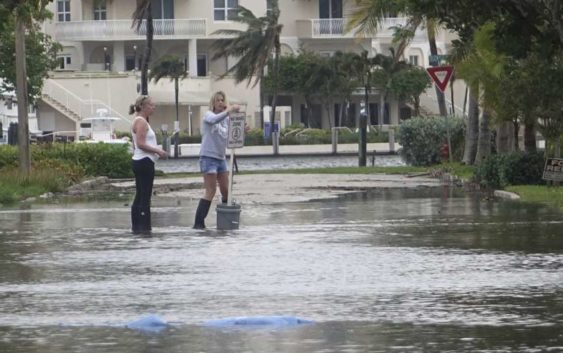- Montgomery County residents unite to weather freezing temperatures and rebuild after tornado damage
- New charge filed against ex-security guard accused of using hidden cameras to take videos of girls at The Woodlands Mall, Hurricane Harbor
- Mecklenburg County residents can attend sessions this week to apply for Hurricane Helene disaster relief
- Steiner Ranch deploys goats for wildfire prevention efforts
- Goats graze greenbelt to reduce wildfire risk in Steiner Ranch
Scientists say rising seas will break flooding records

-
FILE – In this Oct. 5, 2017, file photo, residents move a “no wake,” sign through flood waters caused by king tides in Fort Lauderdale, Fla. Federal scientists, according to a report released Wednesday, July 10, 2019, predict 40 places in the U.S. will experience higher than normal rates of so-called sunny day flooding this year due to rising sea levels and an abnormal El Nino weather system. (Joe Cavaretta/South Florida Sun-Sentinel via AP) lessFILE – In this Oct. 5, 2017, file photo, residents move a “no wake,” sign through flood waters caused by king tides in Fort Lauderdale, Fla. Federal scientists, according to a report released Wednesday, July … more
Photo: Joe Cavaretta, AP
Photo: Joe Cavaretta, AP
ATLANTIC CITY, N.J. (AP) — Federal scientists predict 40 places in the U.S. will experience higher than normal rates of so-called sunny day flooding this year due to rising sea levels and an abnormal El Nino weather system.
A report released Wednesday by the National Oceanographic and Atmospheric Administration predicts that sunny day flooding, also known as tidal flooding, will continue to increase.
“Annual flood records are expected to be broken again next year and for years and decades to come from (sea-level) rise,” the report read. “Flooding that decades ago usually happened only during a powerful or localized storm can now happen when a steady breeze or a change in coastal current overlaps with a high tide.”
Sunny day flooding occurs during high tide events, like full moons.
The nationwide average frequency of sunny day flooding in 2018 was five days a year, tying a record set in 2015.
But the East Coast averaged twice as much flooding.
The agency says the level of sunny day flooding in the U.S. has doubled since 2000.
Nationwide, the agency predicted, average sunny day flooding could reach 7 to 15 days a year by 2030, and 25 to 75 days a year by 2050.
“We cannot wait to act,” said Nicole LeBoeuf, acting director of NOAA’s Ocean Service. “This issue gets more urgent and complicated with every passing day.”
Global sea levels are rising at a rate of about 3 millimeters a year, or about an inch every eight years, according to Rutgers University researchers, who predict that by 2050, seas off New Jersey will rise by an additional 1.4 feet (0.4 meters).
The study noted floods interfering with traffic in northeast states, swamping septic systems in Florida and choking Delaware and Maryland coastal farms with saltwater over the past year.
Baltimore experienced 12 days of high-tide flooding from 1902 to 1936. Within the last 12 months, it experienced an additional 12 days.
“Impacts are here and now,” said William Sweet, a NOAA oceanographer and lead author of the study. “The future is already here, a floodier future.”
Robert Kopp, a leading climate scientist with Rutgers University, who was not involved in the study, said it confirmed many well-established trends.
“It’s simple arithmetic: If you have higher sea level, you will have tides causing flooding,” he said. “We’re not talking about disaster flooding. We’re talking about repetitive flooding that disrupts people’s lives on a daily basis. It’s sometimes called ‘nuisance flooding,’ but it has real impacts and costs.”
The report cited the disruption of commerce in downtown Annapolis, Maryland, where parking spaces are lost to flooding. A 2017 study put the price tag on lost economic activity at as much as $172,000. The water table has risen to ground level and degraded septic systems in the Miami region, and farmlands in the Delmarva Peninsula in Delaware and Maryland have been damaged by salt water encroaching into planted areas.
High-tide flooding is causing problems including beach erosion, overwhelmed sewer and drinking water systems, closed roadways, disrupted harbor operations, degraded infrastructure and reduced property values — problems which “are nearly certain to get much worse this century,” the report read.
The report’s statistics cover May 2018 through April 2019.
The agency forecasts sunny-day flooding this year in Boston at 12 to 19 days (it had 19 last year). It predicted sunny-day flooding this year in New York (8 to 13 days, compared with 12 last year); Norfolk, Virginia (10 to 15 days; compared to 10 days last year); Charleston, South Carolina (4 to 7 days, compared to 5 last year); Pensacola, Florida (2 to 5 days compared with 4 last year); Sabine Pass, Texas (6 to 13 days compared with 8 last year) and Eagle Point, Texas (29 to 40 days, compared to 27 last year).
West coast predictions included San Diego (5 to 9 days compared to 8 last year); Los Angeles (1 to 4 days compared to 5 last year); Humboldt Bay, California (6 to 12 days compared to 12 last year); Toke Point, Washington (9 to 21 days compared to 12 last year) and 2 to 6 days in Seattle, compared to 2 last year.
The report documented that 12 locations broke or ties their record of sunny-day flooding last year, including 22 in Washington, D.C., 14 in Wilmington, North Carolina; and 12 each in Baltimore and Annapolis.
___
Follow Wayne Parry at http://twitter.com/WayneParryAC